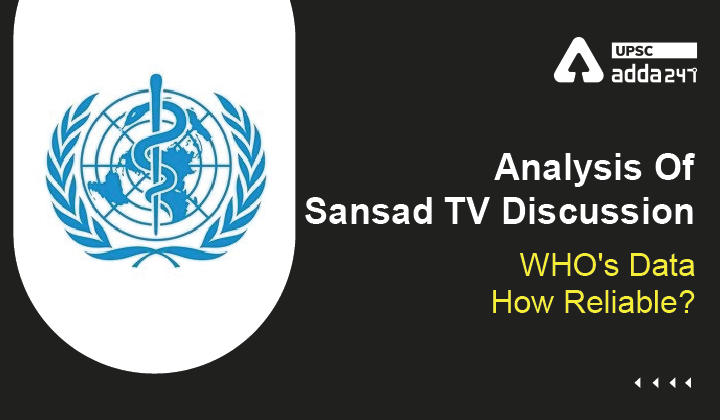Table of Contents
Analysis Of Sansad TV Discussion
‘WHO’s Data: How Reliable?’
Relevance
”GS 3: Health
Context
- A report by the WHO released last week claimed that there were an estimated 4.7 million deaths in India in 2020 and 2021, directly or indirectly attributable to the Covid- 19 pandemic.
- This is the highest for any country and nine times the nation’s official count of 5,24,000 as of May 2022.
- The apex public health agency said that these numbers are the highest so far for any country and constitute around a third of the 15 million COVID-related deaths at the global scale.
What is wrong with the WHOs Estimate?
- This is in stark contrast to the official data from India.
- As of December 2021, India officially recorded around 4.8 lakh deaths related to COVID-19.
- As of May, India has officially over 5.2 lakh deaths. The WHO’s figure is around 10 times the government’s tally.
- Public health experts have also argued that the science behind the estimation may be taken subjectively.
What is India’s Stand on WHO’s Data?
- India has raised strong objections regarding the mathematical models used by the World Health Organization (WHO) to project excessively high death estimates linked to the coronavirus pandemic.
- India argued that the validity and robustness of the models used and methodology of data collection by WHO are questionable.
- As per the official data released by Union Health Ministry India reported 5 Lakh 24 Thousand 93 deaths till 8 AM on 9th May 2022.
- India had also informed WHO that in view of the availability of authentic data published through the Civil Registration System (CRS) by the Registrar General of India (RGI), mathematical models should not be used for projecting excess mortality numbers for India.
- India also pointed out the inconsistencies in the criteria and assumptions used by WHO to classify countries into Tier I and II as well as questioned the very basis for placing India into Tier II countries (for which a mathematical modelling estimate is used).
- India also argued the fact that given the accuracy of the mortality data collected through an effective and robust statutory system, India doesn’t deserve to be placed in Tier II countries.
Loopholes in our reporting system
- There are lots of flaws in our ability to count deaths and determine the causes of deaths.
- India does not have a public health division which can systematically collect and analyse data on diseases.
Such a governmental arm would mandate doctors to report infectious diseases, pick up the earliest signals of outbreaks in any part of the country and keep count of the number of cause-specific deaths. - In the absence of a robust reporting system and standard, hospitals, bureaucrats, civic bodies and even clerks under-report.
- The problems of counting are the same with malaria, typhoid, cholera, rabies, leptospirosis, scrub typhus or death by snake bite.
Conclusion
We need to urgently invest in a robust public health infrastructure that will have to be built from the ground up.



 TSPSC Group 1 Question Paper 2024, Downl...
TSPSC Group 1 Question Paper 2024, Downl...
 TSPSC Group 1 Answer key 2024 Out, Downl...
TSPSC Group 1 Answer key 2024 Out, Downl...
 UPSC Prelims 2024 Question Paper, Downlo...
UPSC Prelims 2024 Question Paper, Downlo...
